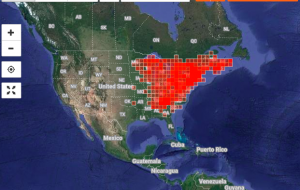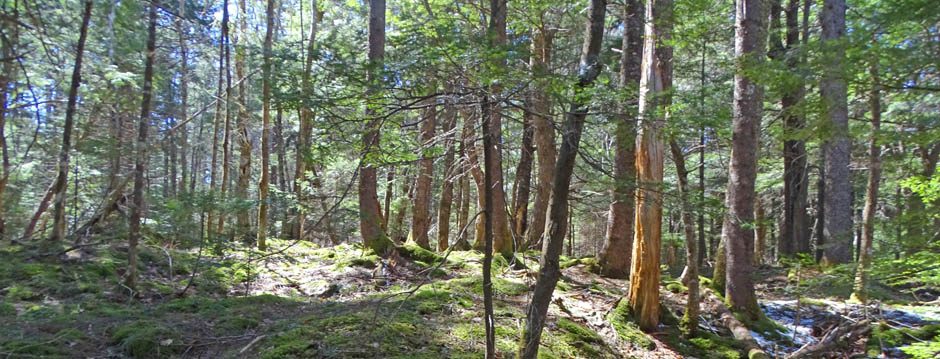| HWA in Nova Scotia Subpages – Eastern Hemlock Notes (THIS PAGE) – About “In the Quiet & the Dark” – Comprehensive Info – The Adelgid – Pesticide Treatment – Biological Control – Silviculture – Post HWA infestation Impacts |
On its distribution

Observations of E. Hemlock reported on iNaturalist
From Miles and Smith (1960): “Nova Scotia is placed within the Hemlock – White Pine -Northern Hardwood Forest Region by Nichols (22). This region, although transitional between the boreal forest to the north and the deciduous forest to the south, contains species which are more or less confined to it, and which give the region an ecological distinctness (22, 1). These characteristic species are hemlock (Tsuga canadensis (L.) Carr.), red spruce (Picea rubens Sarg.), white pine (Pinus Strobus L.) and yellow birch (Betula lutea Michx. f.). Rowe (24) included most of the Maritime Provinces within the Acadian Forest Region, which corresponds approximately to the eastern part of the Hemlock -White Pine – Northern Hardwood Region of Nichols.
“Hemlock occurs in varying amounts throughout the province of Nova
Scotia. In Cape Breton Island and in the northeastern portion of the mainland it is relatively rare, occurring mainly mixed with deciduous species on the slopes of ravines and in brook valleys. The species becomes more common toward the southwest, where it occurs in extensive pure stands or mixed with red spruce. The abundance of hemlock in the latter area was reported as early as 1801 by Titus Smith (26). In 1952 Drinkwater (6) estimated that pure stands of hemlock covered approximately 45,000 acres in this region.”
ON ITS KEY CHARACTERISTICS
Extracts from FEIS
Habitat Type & Plant Communities
– Eastern hemlock occurs as a dominant or codominant in coniferous and mixed-hardwood forests.
– It is often the only conifer present in mixed mesophytic forests of the eastern United States [In NS, Black & Red Spruce, Fir often occur in mixed forests with E Hemlock}
Botanical & Ecological Characteristics
– Eastern hemlock is a native, evergreen conifer with heavily foliaged and upsweeping branches.
– At maturity, it is commonly 60 to 70 feet (18-21 m) tall and 24 to 48 inches (61-122 cm) in d.b.h.
– It reaches ages in excess of 800 years (In NS: ~500 yrs)
– Eastern hemlock roots are shallow and widespreading
Regeneration
– Trees begin producing seed when they are 20 to 30 years old.
– This species bears cones every year, and large crops are frequent
– The small winged seeds are dispersed by gravity and
wind; most fall within one-tree-height distance from the source
– Seeds germinate best on moist substrates, such as rotten wood..
– The number of seedlings established on rotten logs and
stumps increases as the wood decays and the moss cover increases.
Seedlings commonly establish on “tip-up mounds” formed by fallen trees
– A young dense stand may exclude regeneration for many years because of severe root competition
– Hemlock regeneration is present in the understory of stands
with a parent overstory density of up to 140 square feet per acre
– Eastern hemlock does not sprout and layers only rarely
Site Characteristics
– At its western and southern limits, eastern hemlock is confined to moist cool valleys, moist flats, northern and eastern slopes, coves, benches, and ravines.
-In the northern part of its range, it tolerates drier and
warmer sites.
-Favorable eastern hemlock sites are moist to very moist with good
drainage.
-hile generally considered a moisture-demanding species, eastern hemlock grows on dry sites protected from fire, such as rocky ledge
-Understory associates are scarce because of acidic infertile humus, low light, and cool conditions
Successional Status
– Eastern hemlock is very shade tolerant
– Saplings less than 2 inches (5 cm) in d.b.h. may be more than 100 years old
-Eastern hemlock requires partial shade for establishment and is a late colonizer of disturbed sites
– Eastern hemlock uniquely modifies semipermanent soil properties, such as acidity, which favors its reproduction. Opportunities to establish in a mature forest increase over time as nurse logs and tip-up mounds accumulate
-The general designation of eastern hemlock as a climax species has been questioned…. [quite complicated; for NS see Miles & Smith (1960)
Fire Ecology
– Eastern hemlock is very susceptible to fire because of its thin bark, shallow roots, low-branching habit, and heavy litter deposits
It is possibly the most fire-sensitive mesophytic tree species in its range
– Eastern hemlock usually escapes fire because it occurs in moist habitats and is often associated with hardwoods which do not readily burn
– Vogl considers eastern hemlock a fire-initiated species rather than a fire-independent species because it benefits from fire-prepared seedbeds. However, suggestions that fire promotes regeneration of eastern hemlock are not well documented. Given the difficulties in accurate age estimates because of heart rot, Rogers [51] suggests that even-aged eastern hemlock forests that regenerated after fire may actually be uneven-aged.
On Broader Ecological Significance
Extracts from Eastern Hemlock Project (Ontario)
Eastern hemlock is a tree of shorelines and river valleys…
Hemlock is known as a foundation species*, because it exerts such a strong influence on ecosystems where it grows.
The dense shade of hemlock groves cools streams throughout the summer – streams that run through hemlock valleys average about one to two degrees Celcius cooler than in nearby hardwood forests, creating important habitat for cold-water fish species such as brook trout.
Hemlock also helps maintain summer water levels in streams by holding spring snowpack longer, and reducing summer evaporation.
———
*Experiments Are Revealing a Foundation Species: A Case Study of Eastern Hemlock (Tsuga canadensis)
Aaron M. Ellison, Advances in Ecology Volume 2014, Article ID 456904, 11 pages PDF
